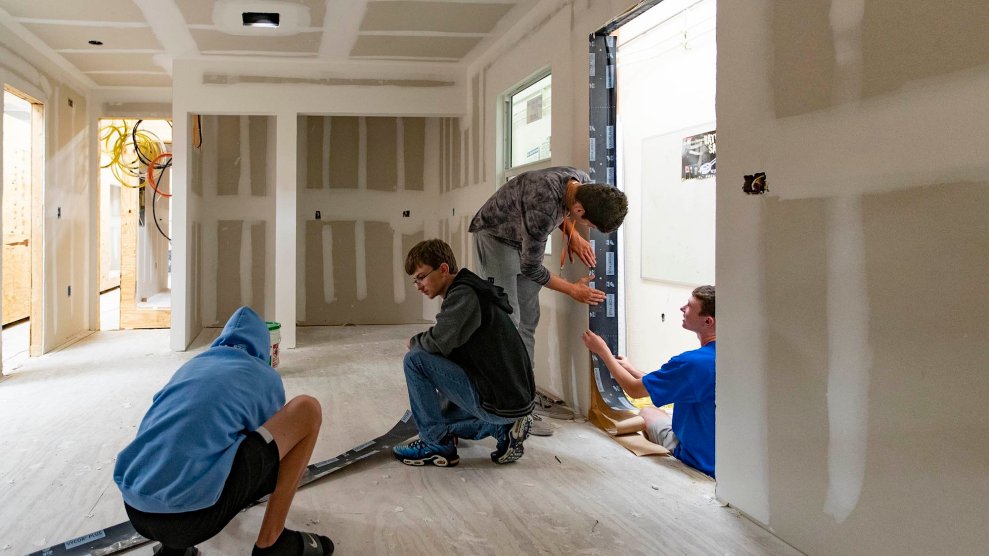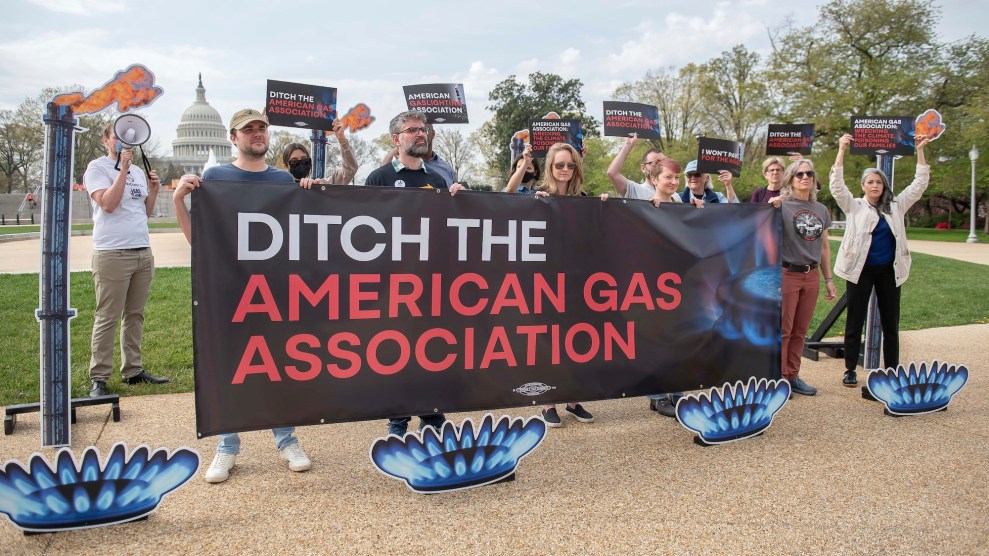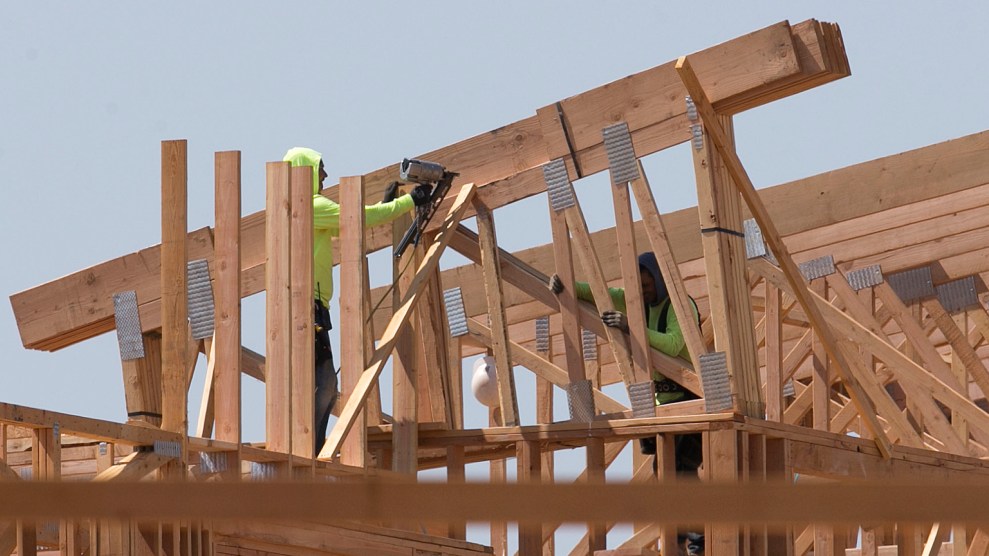
A 2019 Habitat for Humanity building project in Florida.llen Eyestone/The Palm Beach Post/Zuma
This story was originally published by the Guardian and is reproduced here as part of the Climate Desk collaboration.
US gas utilities are partnering with one of the nation’s most trusted nonprofits as part of a “cynical PR stunt” to combat efforts to curb fossil fuel usage, a Guardian investigation has found.
Local Habitat for Humanity affiliates have teamed up with at least four utilities across 10 states to build “zero-net energy homes,” which are meant to produce more energy than they use.
The houses, which are sold at affordable rates to low-income families, are weatherized and meticulously insulated to boost efficiency and equipped with rooftop solar panels. But they also come with appliances powered by gas, a planet-heating fossil fuel that has been shown to degrade indoor air quality.
The utilities say the homes provide lower electricity bills and affordable mortgages for vulnerable families.
“The two great existential crises that most people face are eviction and climate breakdown, and the second one is making the first one worse.”
“It’s part of our culture to really give back to the communities that we serve,” Jennifer Altieri, vice-president of public affairs for Atmos Energy’s Colorado-Kansas division, said in a video announcing the utility’s first Habitat home in Evans, Colorado, in September 2021, which was provided to a single mother and her children.
Yet Atmos has privately described the project as something closer to a public relations tactic, intentionally launched in a state that is “on the frontlines” of attempts to quell reliance on gas.
Atmos has since expanded the Habitat partnerships to seven communities, with plans to launch similar initiatives in at least two more. National Fuel in the Northeast, SoCal Gas in Southern California, and Nicor in Illinois have also partnered with Habitat on zero-net energy (ZNE) projects.
The moves by utilities to attach themselves to social justice causes come as the US is embroiled in a broader political culture war over federal, state, and local attempts to phase out gas and make new buildings electric.
The projects by Atmos and others have won widespread praise from gas interest groups. An autumn 2022 feature in Southeast Gas’s magazine Natural Living says the Atmos-Habitat partnerships promote “healthy living,” and that same year, its Evans, Colorado, home was a finalist for an ESG award from the Southern Gas Association. “These ZNE homes demonstrate that natural gas is a part of the solution to achieve our low-carbon energy future,” the award submission says.
Habitat for Humanity International has participated in international climate negotiations and says it prioritizes climate safety. In a statement, the nonprofit said: “We know that innovation is required so future construction doesn’t exacerbate the climate crisis.”
Habitat for Humanity says it helps millions of people access affordable homes each year who are often “among the most vulnerable to the effects of climate change.” But to do so, it relies on independent, locally run affiliates, which can decide how houses are built and funded.
Asked about the perceived conflict between the gas utility partnerships and its climate-related statements, a spokesperson for the organization said the group’s affiliates “engage a wide range of partners.” The world is “facing a growing crisis in affordable, adequate housing” which requires “a multi-faceted challenge that demands nonprofit organizations, individuals, corporate partners, elected officials and more to work alongside one another,” he said.
He said Habitat’s advocacy and partnerships were “designed to confront the housing crisis and ensure more people have a decent place to call home.” But critics say those arrangements appear to have opened the door for gas utilities to attach themselves to the organization and its reputation.
“It’s a cynical PR stunt by the gas utilities,” said Itai Vardi, research and communications manager at the utility watchdog group the Energy and Policy Institute, which provided some research about the partnerships to the Guardian. “We know that we need to transition very rapidly and dramatically off of fossil fuels, and there’s really no good reason to build new construction that is not all electric.”
“Zero-net energy” is a building standard requiring a home to produce as much energy as it uses. Builders first work to boost a home’s efficiency with insulation and air sealing, then equip the home with energy production capacity, such as solar panels.
But efficient homes that still use gas should not be considered climate-friendly, said Mike Henchen, who leads the carbon-free buildings program at the pro-electrification nonprofit RMI. “When it comes to climate, gas is part of the problem,” he said. “There’s this effort to hype natural gas as clean energy, but it’s not.”
Gas is primarily composed of methane, a greenhouse gas 80 times more planet-warming than carbon dioxide in the short term.
In the US, gas accounts for the vast majority of planet-heating pollution from buildings, which makes up more than one-tenth of all US greenhouse gas emissions.
At a zero-net dedication, a utility rep claimed that the air quality in the home would be of “the best quality breathing air that you can have.”
The utilities say the projects illustrate that gas can be part of decarbonization efforts. Describing its Habitat partnerships to American Gas Magazine, a representative from the gas utility Nicor said: “These homes demonstrate the importance of natural gas as part of a diverse energy mix in a net-zero future.”
Jennifer Golz, spokesperson for Nicor, said that “research shows a hybrid energy approach will help drive greater emissions reductions at lower overall costs” while improving reliability during extreme weather. A spokesperson for Atmos said: “We believe a balanced energy approach that includes natural gas and preserves energy choice, rather than supporting specific fuels or technologies, will achieve goals of reducing emissions while maintaining energy reliability.”
But climate experts agree that gas must be swiftly curbed to avert climate catastrophe.
Spokespeople from Atmos and Nicor did not directly respond to questions about that scientific consensus.
In an emailed comment, a representative from Colorado’s Greeley-Weld Habitat affiliate said: “We have long constructed homes with a variety of energy sources, including natural gas and electricity.”
Daniel Aldana Cohen, a co-director of the progressive thinktank Climate and Community Project, said the gas-powered ZNE projects made an unnecessary compromise: They tie access to affordable housing to increased planet-heating pollution.
“The two great existential crises that most people face are eviction and climate breakdown, and the second one is making the first one worse,” said Aldana Cohen, whose research has informed federal Green New Deal for Public Housing proposals.
Experts have long warned that gas appliances can emit pollutants, including carcinogens. In recent years, a slew of studies have linked gas stoves to increased risk of childhood asthma, chronic lung disease and other health impacts.
Low-income people and people of color may be at higher risk if exposed to these pollutants, as they are more likely to have asthma and other underlying respiratory issues due to disproportionate exposure to environmental contaminants.
Gas trade groups note a recent World Health Organization-funded study found gas stoves had a non-significant impact on childhood asthma. The same study noted a connection between gas use and pneumonia and lower respiratory infections.
“Utilities enter into places where government investment is lacking and use that to promote its product.”
Last year, US regulators suggested a potential eventual nationwide gas stove ban, though Biden later ruled out such a policy.
Yet the utilities behind the partnerships have repeatedly referred to gas as “clean.” And during a dedication ceremony for a zero-net energy home built by a Habitat affiliate and Atmos in Lafayette, Louisiana, a representative from the utility claimed that the air quality in the home would be of “the best quality breathing air that you can have.”
Spokespeople from Atmos and Nicor did not respond to inquiries about whether the ZNE homes included gas stoves. But an Atmos representative in a December 2023 industry webinar said there was “natural gas cooking in these homes, in every single one of them.”
Asked about concerns that gas appliances can degrade indoor air quality, a representative for Atmos Energy directed the Guardian to claims made by the American Gas Association, a major trade group for private gas utilities.
Despite evidence of the dangers of gas, utilities and their interest groups are using the Habitat partnerships as a public relations tool. The Energy Solutions Center, a trade association of gas utilities, cited the partnerships in a gas-promoting marketing document for its members, which was reviewed by the Guardian. (In an emailed statement, the executive director of Energy Solutions Center, Sonia Vahedian, pointed to recent studies that it said showed gas “remains essential for energy security and will significantly contribute to economic security beyond 2050.”)
And during a December 2023 industry webinar, a recording of which was also reviewed by the Guardian, a representative from Atmos said that the project began as a response to attempts to ban gas in buildings.
“In Colorado, they are a little bit on the frontlines, as far as some of the efforts to maybe dissuade people from utilizing natural gas,” a representative of the utility said. “And as such, that became the chosen site for our very first natural gas-fueled ZNE home build.”
Another representative went on to describe the need to produce a “marketable” product. “Like everyone in the natural gas industry…we’ve kept an eye on the growing loud voice for green energy and squeezing out fossil fuels as an energy source,” he said, adding that the partnerships sought to show that “natural gas can be a part of that future solution or transition state.”
The choice to “combine with renewables,” the representative says, is “kind of a great talking point that, ‘Hey, we’re partnering with renewables, we’re not against them.’”
It’s a strategy that was highlighted in a congressional report last month, based on a tranche of subpoenaed internal documents. A 2018 draft presentation from BP said one way to “harness excitement” about renewables was to suggest gas could be a backup fuel source for wind and solar.
Atmos representatives on the call also said Habitat had a “well-oiled machine in terms of public relations.”
“Utilities enter into places where government investment is lacking and use that to promote its product, but also brandish its image through these kinds of PR stunts,” Vardi said.
Each ZNE home in these projects has gone to low-income members of vulnerable communities, including immigrants, people of color and veterans.
“The gas companies,” said Aldana Cohen, “are essentially using poor people as human shields to perpetuate a business model that is going to do the most harm to poor people.”
It’s not the only instance of fossil fuel interests hitching their wagon to this kind of advocacy. Reports show that utilities have long funded Black civil rights leaders; the NAACP in 2020 urged local chapters to stop accepting this funding.
“When you delegate things to any number of non-profits and for-profit companies, you’re far more likely to just get totally self-serving interventions.”
Promotional materials often say the ZNE homes can help lower energy bills.
“Natural gas is really important to the homes we build because it’s reliable, predictable, and affordable month to month,” a representative of the Habitat affiliate in Austin, Texas, said in a 2021 report on environmental, social, and governance investments.
In a 2022 call with financial analysts shared with the Guardian by the Energy and Policy Institute, Atmos’s CEO, Kevin Akers, said the ZNE homes demonstrated “the value and vital role natural gas plays in helping customers reduce their carbon footprint in a cost-effective manner.”
Recent research, however, shows that newer, efficient electric appliances—such as heat pumps and induction stoves—can cost the same amount or even less to run as their gas-powered counterparts, though they can be more expensive to install.
In some cases, utilities are also using customers’ money to pay to build the homes. In Mississippi, public utility commission documents shared by the Energy and Policy Institute show Atmos is recovering costs to build the ZNE homes from ratepayers.
Though the projects are billed “zero-net energy” homes, it is not clear that they are always meeting that goal.
SoCal Gas in 2017 partnered with Habitat for Humanity of Orange county on a ZNE home, and has touted the benefits of “dual-fuel” ZNE homes over all-electric ones, saying customers prefer them.
But a 2021 study funded by SoCalGas and the California Energy Commission comparing two ZNE homes in the city of Stockton—one fully electric model and another home that included both solar panels and gas appliances—seemed to undercut the purported benefits of gas. Researchers found that the all-electric home produced more energy than it used, but the gas-powered model did not achieve ZNE status.
In webinars held last year researchers noted that even when ZNE homes do not achieve “absolute zero,” they can still help to promote efficiency.
ZNE homes with gas can meet the zero-net benchmark—in a statement, Atmos said its Habitat homes have done so—and not all fully electric ZNE homes necessarily achieve the goal. Still, Vardi said the SoCal Gas-funded study provided yet more evidence that gas is unnecessary. “There is really no reason to build new construction that is not all electric,” he said.
Some Habitat partnerships show that this is possible.
Habitat’s affiliate in Cape Cod, Massachusetts, built all-electric homes in partnership with a Cape Cod utility, which in 2021 were the “best-rated” Habitat homes in the nation in terms of efficiency. Another affiliate in Massachusetts’s Pioneer Valley built an affordable, all-electric ZNE home that won praise from the federal government.
This year, the federal government announced $2 billion for a coalition of nonprofits including Habitat for Humanity International and Rewiring America to build fully electric low-income housing.
The projects began amid a widespread lack of affordable housing in the US. A poll this year found that most US renters believe they will never be able to afford a home, and that a majority live in areas that are so unaffordable that they are “barely livable.” Meanwhile, US public housing stock shrank by 25 percent between 2009 and 2022, according to a recent analysis of federal data by Climate and Community Project.
Habitat depends on financial donations to fund their work, which Aldana Cohen said created the opportunity for “dramatic inconsistency or contradiction, like using affordable housing to prop up the gas industry.”
In another example, Habitat International, has accepted donations from the multinational fossil fuel conglomerate Koch Industries. “When you delegate things to any number of nonprofits and for-profit companies, you’re far more likely to just get totally self-serving interventions,” he said.
“There’s no reason to lock a single social policy priority, like affordable housing, into the survival of the fossil fuel industry,” Cohen said.














